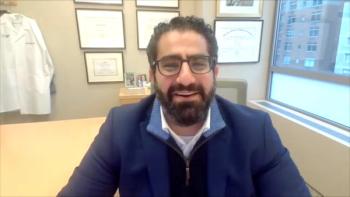
MM and Real-World Evidence
Dr Richter relays some of the differences between real-world evidence (RWE) and RCT data, as well as how they can work together when determining therapy.
Episodes in this series

Ryan Haumschild, PharmD, MS, MBA: I like what you say about needing to evaluate these therapies against current standards of care. As a director who oversees a cancer center, I get frustrated when we bring up something like renal cell carcinoma. People are comparing it with a standard of care or placebo, when we know that’s no longer the standard of care. There are other high-cost agents being utilized. In multiple myeloma, that plays really well. A clinical trial might be comparing something that was standard of care 2 years ago. In the multiple myeloma landscape, 2 years is way too late. How do we start to make those decisions?
I’m going to transition to Josh. There are pros and cons to real-world evidence. Every time we bring it up, some people are excited about it, and some people scoff at it because they want their randomized control trial. Randomized real-world evidence is clinical evidence that regards the usage and potential benefits or risks of a medical product derived from the analysis of real-world data. And as we look at that, and as we look at data from electronic health records and claims registries, what do you think of the real-world data? Does this get you excited? Do you have concerns? How are you seeing the difference between randomized control trials and real-world evidence, its timeliness, and how it drives treatment decisions moving forward?
Joshua Richter, MD: The mere fact that we’re talking about it, here as a group, is a sign of the times. If you were to take a platform like this—they probably didn’t have Zoom a decade ago—or if you got us all in a room in the real world, like we used to do, and someone mentioned real-world data, they would have been shown the exit. As Muhamed [Baljevic] talked about at ASH [American Society of Hematology Annual Meeting] and ASCO [American Society of Clinical Oncology Annual Meeting], it’s increasingly gaining momentum. We’re on the precipice of being able, hopefully, to get even the FDA to consider some of this data for label expansion or label change. At the core of this, an approval of a drug, we still need randomized controlled data. But the approvals are different now. It’s no longer the approval: “Drug X is approved in myeloma.” No, drug X is approved in myeloma, 4 more prior therapies, a PI [proteasome inhibitor], an IMiD [immunomodulatory drug], and a CD38. What happens when we give this in the real world? We realize that you can tweak that a little. There are too many options and combinations out there. We need real-world data to add to it.
The 1 concern I have is the source of data. There’s an old expression, “Garbage in, garbage out.” Some real-world data are prospective, and much of it is retrospective. I’ve done a lot of projects in this area. Adverse events are exceedingly difficult to capture; efficacy end points, a little easier. How long were they on the drug? When did they progress? These are discrete things that we can point out. When it comes to an adverse-event profile and a quality-of-life assessment—in control trials we’re actively looking at this at every time point—you get higher-fidelity information. You must extrapolate. If someone got admitted to the hospital and you don’t have all that information—what grade was it? How severe? How did it impact?—in terms of efficacy, we can pull from real-world data. But the way we’re going to overcome the deficiency of toxicity assessment, in my mind, is to actively develop prospective real-world data assessments. Standing at ground zero, as we move forward, we need to collect all this with as much fidelity as possible. That way, we can look back and say, “These 2 people did about the same, but this person had a lot more toxicity.” Maybe looking forward, a patient of a similar phenotype should not go on that regimen.
Ryan Haumschild, PharmD, MS, MBA: Those are great ones. Looking at specific translocations—11;14 and venetoclax, and nontransplant-eligible patients—how do we see faster adoption in the real world as opposed to the official FDA approval? Those are areas that are interesting to me.
This transcript has been edited for clarity.
Newsletter
Stay ahead of policy, cost, and value—subscribe to AJMC for expert insights at the intersection of clinical care and health economics.

















































